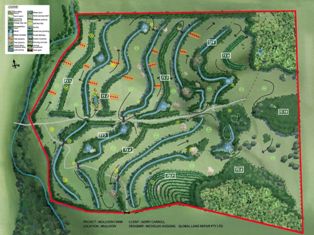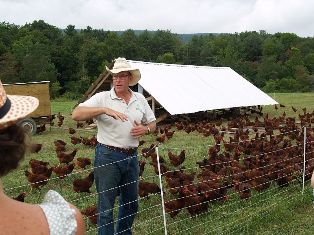Permaculture is a design science for sustainable agricultural environments. Through the observation of natural function, it seeks to integrate and arrange various elements within a farm enterprise (e.g. plants, animals, buildings and infrastructures) in such a way that they support and benefit each other while performing multiple functions (e.g. harvesting water, providing shelter, feeding farm stock).
It was developed in Tasmania during the 1970s by two Australians, David Holmgren and Bill Mollison. They took the view that modern industrial agriculture was too highly dependent on the use of non-renewable resources and that this was leading to reduced biodiversity and increasing pollution of soils and water. In response, they developed a design process for agricultural systems that would sustain the needs of both nature and human habitation. They coined this process of sustainable agriculture 'permaculture'.

Core ethics
Permaculture has 3 core ethics at its foundation:
- care of the earth
- care of people
- a fair share of resources.
The last core value implies limits on the consumption of resources are needed and that humanity must find ways to live within these limits.
The overriding intention of the design process is to provide sustainable human habitation within agriculture. Due to its focus on natural ecosystems, it borrows heavily on other nature-orientated approaches to agriculture such as organics, biodynamics and biological farming. However, what distinguishes it from others are 12 design principles, which are structured and scientific in their approach. They look for positive outcomes and opportunities and use feedback mechanisms to evaluate and self regulate.
This results in systems for sustainable agriculture that are responsive to change and will evolve over time. The approach allows ideas to be adopted from any source, even from conventional chemical farming systems. This allows systems to be developed that are based on sound reasoning and not blind dogma. All too often, 'nature-friendly' systems of agriculture turn into exercises of what you 'can't do' rather than 'what's possible'.
The principles themselves are broad in their description and flexible in their interpretation. This has resulted in many different implementations which can now be found throughout the world. These include urban as well as rural situations.
The design process
The first step in any farm permaculture design focuses on 3 key aspects:
1. Water – the harvesting and collection of water and slowing its movement through landscape.
2. Access – the design of roads and access so that this element has multiple functions, e.g. vehicle access, water harvesting, stock lanes.
3. Structures – the strategic placement of structures is the final step in designing because 90% of the time the first two steps are not flexible. Structures include buildings, but can also include wood-lots, hedgerows, ponds and crops animals, i.e. various elements serving functions within the farm.
Tools used in implementing the permaculture design process
1. Zones
Zones are a way of grouping design elements according to their demand for use, for example different areas on a farm can be considered different zones. Z zones can be designated from 1 to 4. Zone 1 might typically be an area closest to the farm house; zone 2 would be the next area further out; zone 3 the next again and 4 the furthest out. The idea is that zones associated with home activities, and are frequently used and require the most attention and input, are situated close to the house for convenience and efficiency. A zone 1 area might typically include the vegetable and herb garden. In contrast, a zone 4 area might require little attention or is infrequently used. It might typically include long lived perennials such as found in agroforestry or a firewood coppice.
2. Layers
Layers are functional units used in forest design. A 'number 1 layer' might include the tallest of trees; a number 2 layer smaller trees such as fruit trees; a number 3 layer shrubs; a number 4 layer herbaceous plants and small perennials and so on. Thoughtful placement of these varying layers can be used to build functioning agricultural ecosystems.
3. Edges
This concept exploits an observation in nature that where very contrasting habitats meet, such as where a forest meets an ocean, ecosystems are rich in activity and productivity. A design might emulate this phenomenon, for example on a farm pond by having the shoreline formed into several fingers that spiral out into the surrounding land. This enhances the pond edge effect resulting in greater productivity within the shoreline ecosystem. Likewise, crops can planted out in similar patterns to achieve similar productivity outcomes.
4. Guilds
A guild is a group of different plants that happily share similar environments and can be planted together. Plant guilds can provide mutual benefits. For e example, one plant species in a guild might be good at attracting beneficial insects from which all species within the guild benefit.
Example of an innovative sustainable agriculture solution by Joel Salatin
Where there is a good understanding of ecosystem interactions, bringing various design elements together using this process can result in some innovative solutions for sustainable agriculture, such as in the following example of a method used by small farming guru Joel Salatin. On his farm Polyface, Joel Salatin uses free range poultry housed in moveable 'tractor coops'. Typically, these coops are moved daily onto pastures that have been recently grazed by stock. As the poultry forage amongst the pastures, their eating and scratching activities provide valuable weed and insect control. Their scratching activities improve soil aeration while their droppings contribute to soil nutrient cycling and organic matter levels. While supplementary feed is still required using this system, feed costs are lower while their droppings, instead of being a potential liability, become a valuable asset. The bonus is having access to great tasting free-range eggs and meat.

Where to from here?
Potentially, small farm operations have much to benefit from permaculture.
Its design process is very farm specific and ensures the best use is made of a property's natural capital. Adopters of the science can expect high levels of farm function, fertility, biological capital and well-being to ensue.
Workshop courses are commercially available as are qualified consultants who can advise and assist in system design.
For agriculture to serve humanity sustainability, we not only need to learn how to live within the limits of our environment, we also need to explore and develop these limits through utilising the very best of our scientific knowledge and know how. For this, permaculture offers a compelling way forward.
Acknowledgement: Nick Huggins from Permaculture Business World has kindly contributed to this article.
|
|
The author, Roger Martyn has spent 20 plus years working in agriculture and horticulture since graduating from Massey University with an Agricultural Science degree. He has helped many farmers improve their farm productivity and profitability as well as often increasing the enjoyment they got out of farming. |




